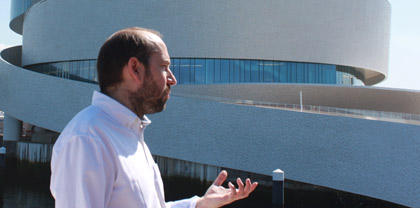Interviews

The collective importance of architecture | by Roberta Chionne
What is the state of architecture in Portugal today? It has maintained a substantial degree of precision and rigour but is losing much of its artisanal character, believes architect Luís Pedro Silva, founder of the practice Luís Pedro Silva Arquitecto Lda and a professor at the Porto School of Architecture FAUP since 2000. Among his many projects, the Porto Cruise Terminal – completed in 2015 and clad with a million Portuguese-made three-dimensional ceramic tiles – is one that exemplifies the special relationship between this material and Portugal, where it has been used for more than 500 years. “Today ceramic tile is an ever-present element that is undergoing intense experimentation,” says Silva. “It has enormous dignity as a material that is part of the Portuguese tradition. The challenge now is to diversify products while integrating technologies imported from the fields of chemistry or electronics.”
Mr Silva, could you give us a brief overview of your practice and its design philosophy?
We specialise in architecture projects with a broad sense of spatial organisation, allowing us to integrate and coordinate a wide range of disciplines while at the same time conducting studies, projects and consultancy in various areas of intervention. Specifically, we have a high level of expertise in interconnecting these different scales and disciplines and placing them at the service of design and spatial organisation. Through our strong commitment to research, our practice has gradually developed awareness of the collective importance of architecture, focusing in particular on aspects of an environmental and social nature, which we systematise in order to integrate them into the project space. Along with technical and disciplinary concerns in searching for customised solutions, we work proactively to ensure compliance with deadlines and budgets at all stages of the project and work in close cooperation with the client and the various actors in the project and construction process.
What projects do you consider to be most representative of your work and why?
We try to maintain the same philosophy throughout all our projects regardless of their scale and programme. The contest for the Farfetch campus (100,000 m2) involved the same level of commitment as a 40 m2 store we designed for the centre of Porto.
How would you describe contemporary Portuguese architecture?
It seems to me that Portuguese architecture maintains a substantial degree of precision and rigour. I have been working as a professor at FAUP for the last 21 years and I don’t see any less commitment on the part of either students or professors. I believe the large-scale transformations currently in progress pose a risk of increasing standardisation and the gradual disappearance of the true artisans who carry out construction work. That prospect is extremely alarming!
Porto Cruise Terminal, Matosinhos, Portugal (© Fernando Guerra | FG+SG)
What is the current state of the construction industry in Portugal?
The construction industry is facing a very challenging period because it has lost much of its artisanal character. As it becomes increasingly global, it is losing flexibility. It shouldn’t be that way.
Have lifestyle and demands changed in these last few years? How has the Covid pandemic affected architects’ work?
We live in a period of enormous uncertainty and shifting paradigms in almost every field. A time of significant prosperity seems to be followed by a crisis and new opportunities. Covid has merely precipitated the transition. Our practice adapted well to teleworking, but we returned to the office as soon as it was possible. We continue to hold distance meetings digitally.
What role do ceramic tiles play in your projects?
Unlike in the past, ceramic tiles are now widely used and are undergoing intense experimentation. Because Portugal was one of the countries in direct contact with Arab civilisation, these products have been part of the Portuguese tradition for more than 500 years. Ceramic is an extremely durable material that can compete comfortably with more modern surface covering materials while retaining a strong soul and sense of dignity. These aspects are widely visible in the city of Porto. We are still striving to modernise the material’s role in architecture.
What are the main trends in the ceramic industry in Portugal today?
The industry is highly diversified, offering everything from masonry blocks to roofing tiles, bathroom fittings and floor and wall tiles. I believe that the challenge is to diversify products while integrating technologies imported for example from the fields of chemistry and electronics.
In your opinion, what is the difference between Italian ceramic products and the others?
Since Portugal has an abundance of ceramic producer companies with a strong tradition of technology and design, we have never really needed to resort to Italian products. We are already carrying out research into ceramics for use in photovoltaic systems.
December 2021














